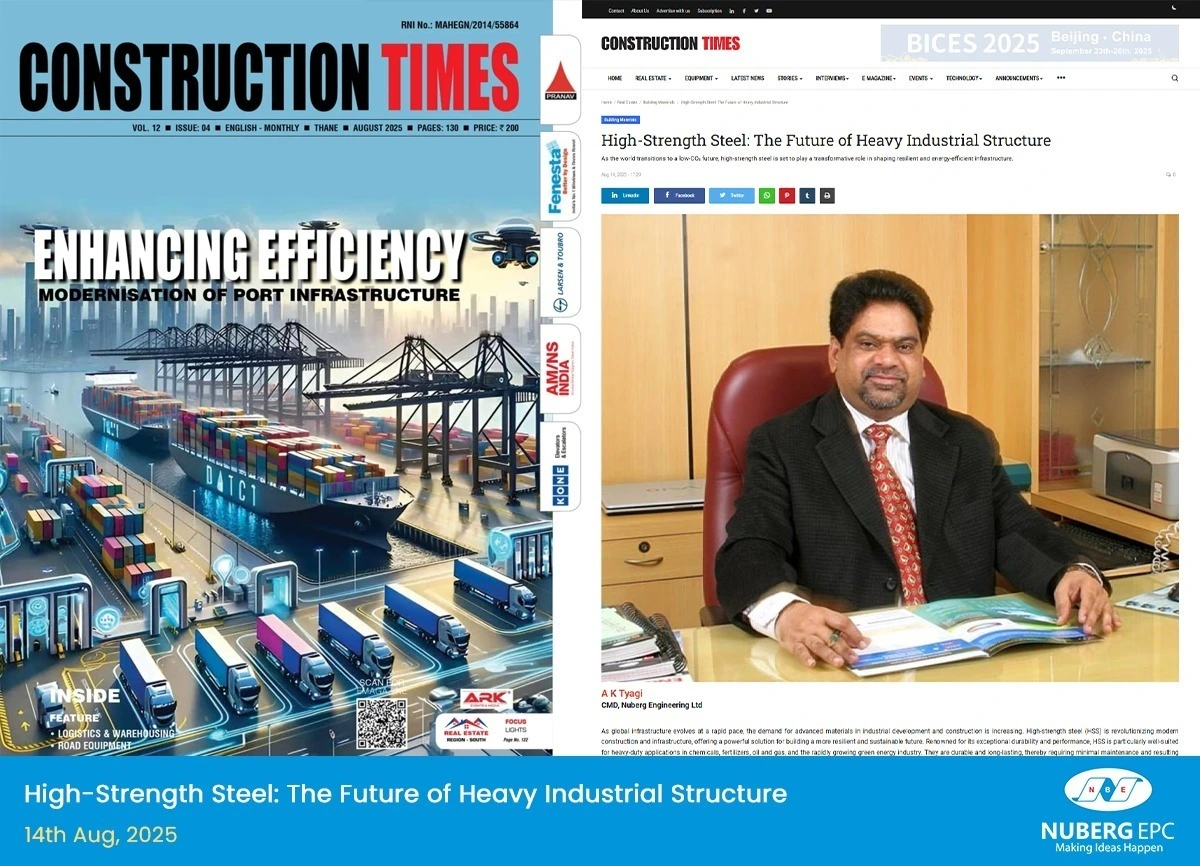High-Strength Steel: The Future of Heavy Industrial Structure
As the world transitions to a low-CO₂ future, high-strength steel is set to play a transformative role in shaping resilient and energy-efficient infrastructure.
Construction Times, Aug 14, 2025

As global infrastructure evolves at a rapid pace, the demand for advanced materials in industrial development and construction is increasing. High-strength steel (HSS) is revolutionizing modern construction and infrastructure, offering a powerful solution for building a more resilient and sustainable future. Renowned for its exceptional durability and performance, HSS is particularly well-suited for heavy-duty applications in chemicals, fertilizers, oil and gas, and the rapidly growing green energy industry. They are durable and long-lasting, thereby requiring minimal maintenance and resulting in lower pollutant emissions over their operational lifespan. After carbon neutrality goals, climate promises and green energy projects, HSS is not just a strong material but a prime enabler to sustainable industrial growth. High-strength steel isn’t just for building materials; it’s an important source of innovation for the industrial infrastructure of the future.
High-strength steel: What is it?
High-strength steel is a new class of advanced steel developed with exceptional mechanical properties. HSS exhibit very high tensile strength, superior ductility, and enhanced pressure resistance. One of the key advantages of HSS is its higher yield strength compared to conventional structural steel. This means it can withstand greater stress and pressure before deforming, allowing engineers to use less material without compromising structural integrity. As a result, HSS offers a more efficient and lightweight solution for demanding applications.
The significance of high strength steel
Structural transformations are taking place in industrial sectors. Companies now seek materials that help save time and reduce carbon footprints in construction projects, while also resisting corrosive environments, high loads, and temperature variations. That is exactly what high strength steel does with its amazing yield and tensile strength. The lighter buildings also require lesser material than traditional steel to complete. This saves time and money for developers and helps meet global targets to cut embodied carbon in infrastructure.
In the EPC sector, structural steel has traditionally been the material of choice for industrial buildings. However, as projects such as large-scale hydrogen plants, desalination units, and cryogenic storage terminals grow in size and complexity, the limitations of conventional materials are becoming increasingly apparent. High-strength steel emerges as a powerful alternative, offering superior mechanical properties, greater load-bearing capacity, and enhanced resistance to environmental stress.
An organic partner for renewables
As the world shifts toward low-carbon and net-zero industrial solutions, green energy infrastructure is becoming central to EPC operations. High-strength steel supports this transition by ensuring mechanical integrity in demanding environments, making it ideal for offshore wind farms, carbon capture and storage (CCUS), and green hydrogen projects. Applications of high-strength steel in green energy projects:
Green hydrogen plants: Compact, lightweight steel structures use less land and cut construction emissions.
Sustainable fuels & carbon capture: HSS is essential in pipelines, reactors, and CO₂ absorption towers used for producing green methanol, ammonia, and SAF (sustainable aviation fuel). Its superior strength and chemical resistance ensure high performance under pressure.
Efficiency-based sustainability
In Industrial construction, two key pillars of sustainability are energy efficiency and lifecycle carbon emissions. Both are positively impacted by HSS
Material efficiency: High-strength steel achieves the same structural performance with less material, reducing emissions from raw material extraction, processing, and fabrication.
Transportation & assembly: Lighter components lower fuel consumption, reduce transportation trips, and speed up crane and crew time on-site, saving both energy and cost.
Long lasting operation: These advanced alloys resist corrosion, fatigue, and cyclic stress, offering longer service lives and fewer replacements, especially in industrial settings.
Recyclability and circular use:Steel is nearly 100% recyclable. Many high-strength steel grades are now made from recycled content and are fully recyclable at end of life, reinforcing circular economy goal.
Future prospects
The need for future-ready EPC projects that are stronger, more efficient, greener, and technologically advanced will increase significantly over the next ten years. To achieve these demands, high-strength steel will be crucial, particularly in infrastructure for smart cities, retrofitting green industries and chemical processing facilities that are climate robust. HSS will continue to transform the way we create and maintain industrial ecosystems through advancements in material processing, digital engineering (BIM, AI-integrated design), and green certifications.
High-strength steel is more than a new-fangled material. It’s a key enabler of the next generation of heavy industrial and green infrastructure. Businesses aiming to merge technical innovation with environmental sustainability gain dual advantages by leveraging high-strength steel. They offer not just enhanced sustainability, but also superior performance. As the world transitions to a low-CO₂ future, high-strength steel is set to play a transformative role in shaping resilient and energy-efficient infrastructure.
© This article was first published in Construction Times. 14 Aug, 2025.
Media Gallery
Construction Times - High-Strength Steel: The Future of Heavy Industrial Structure
Download PDF

